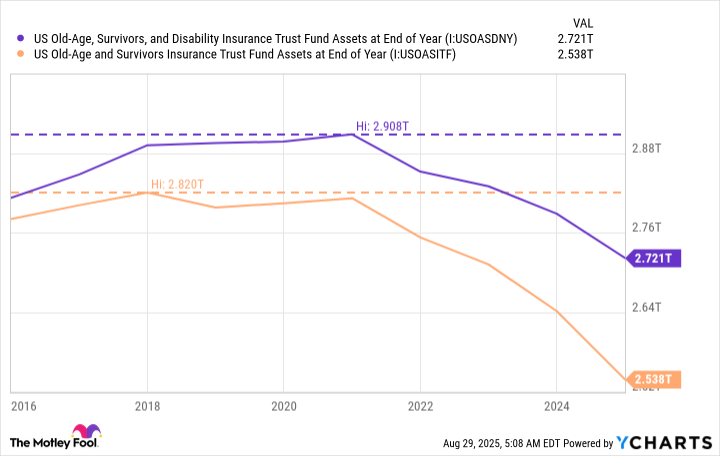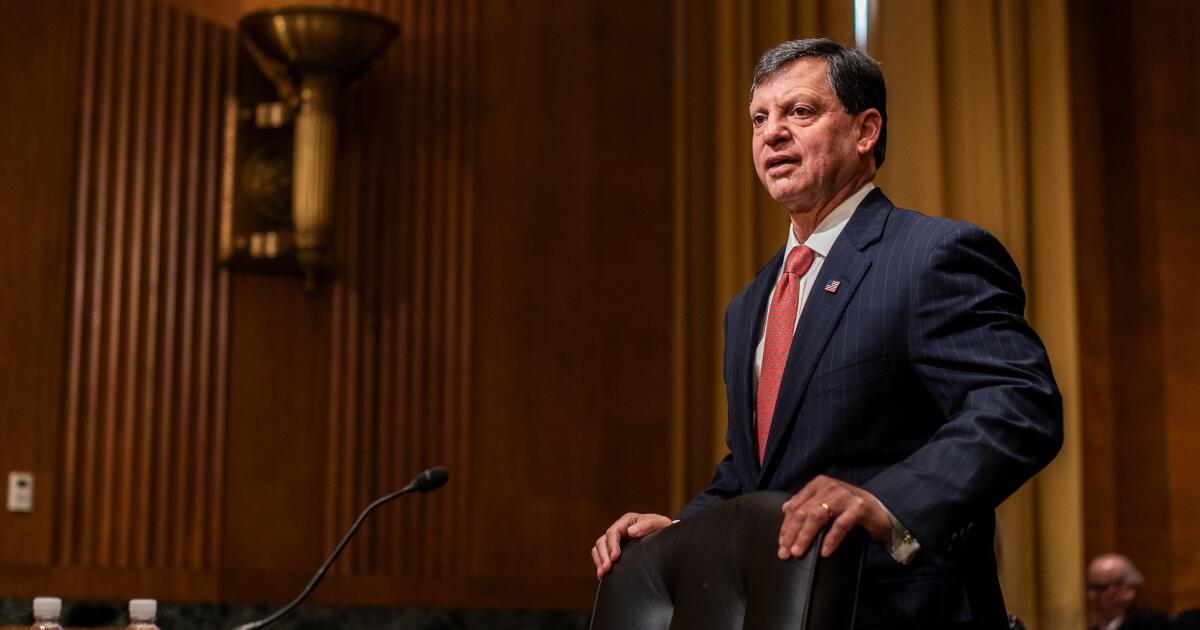John McGing couldn’t reach a human. That might be business-as-usual in this economy, but it wasn’t business; he had called the Social Security Administration, where the questions often aren’t generic and the callers tend to be older, disabled, or otherwise vulnerable Americans.
McGing, calling on behalf of his son, had an in-the-weeds question: how to prevent overpayments that the federal government might later claw back. His call was intercepted by an artificial intelligence-powered chatbot.
No matter what he said, the bot parroted canned answers to generic questions, not McGing’s obscure query. “If you do a key press, it didn’t do anything,” he said. Eventually, the bot “glitched or whatever” and got him to an agent.
It was a small but revealing incident. Unbeknownst to McGing, a former Social Security employee in Maryland, he had encountered a technological tool recently introduced by the agency. Former officials and longtime observers of the agency say the Trump administration rolled out a product that was tested but deemed not yet ready during the Biden administration.
“With the new administration, they’re just kind of like, let’s go fast and fix it later, which I don’t agree with, because you are going to generate a lot of confusion,” said Marcela Escobar-Alava, who served as Social Security’s chief information officer under President Joe Biden.
Some 74 million people receive Social Security benefits; 11 million of those receive disability payments. In a survey conducted last fall, more than a third of recipients said they wouldn’t be able to afford such necessities as food, clothing, or housing without it. And yet the agency has been shedding the employees who serve them: Some 6,200 have left the agency, its commissioner told lawmakers in June, and critics in Congress and elsewhere say that’s led to worse customer service, despite the agency’s efforts to build up new technology.
Take the new phone bot. At least some beneficiaries don’t like it: Social Security’s Facebook page is, from time to time, pockmarked with negative reviews of the uncooperative bot, as the agency said in July that nearly 41% of calls are handled by the bot.
Lawmakers and former agency employees worry it foreshadows a less human Social Security, in which rushed-out AI takes the place of pushed-out, experienced employees.
Anxieties across party lines
Concern over the direction of the agency is bipartisan. In May, a group of House Republicans wrote to the Social Security Administration expressing support for government efficiency, but cautioning that their constituents had criticized the agency for “inadequate customer service” and suggesting that some measures may be “overly burdensome.”
The agency’s commissioner, Frank Bisignano, a former Wall Street executive, is a tech enthusiast. He has a laundry list of initiatives on which to spend the $600 million in new tech money in the Trump administration’s fiscal 2026 budget request. He’s gotten testy when asked whether his plans mean he’ll be replacing human staff with AI.
“You referred to SSA being on an all-time staffing low; it’s also at an all-time technological high,” he snapped at one Democrat in a House hearing in late June.
But former Social Security officials are more ambivalent. In interviews with KFF Health News, people who left the agency — some speaking on the condition of anonymity for fear of retribution from the Trump administration and its supporters — said they believe the new administration simply rushed out technologies developed, but deemed not yet ready, by the Biden administration. They also said the agency’s firing of thousands of employees resulted in the loss of experienced technologists who are best equipped to roll out these initiatives and address their weaknesses.
“Social Security’s new AI phone tool is making it even harder for people to get help over the phone — and near impossible if someone needs an American Sign Language interpreter or translator,” Sen. Elizabeth Warren (D-Mass.) told KFF Health News. “We should be making it as easy as possible for people to get the Social Security they’ve earned.”
Spokespeople for the agency did not reply to questions from KFF Health News.
Using AI to automate customer service is one of the buzziest businesses in Silicon Valley. In theory, the new breed of artificial intelligence technologies can smoothly respond, in a human-like voice, to just about any question. That’s not how the Social Security Administration’s bot seems to work, with users reporting canned, unrelated responses.
The Trump administration has eliminated some online statistics that obscure its true performance, said Kathleen Romig, a former agency official who is now director of Social Security and disability policy at the left-leaning Center on Budget and Policy Priorities. The old website showed that most callers waited two hours for an answer. Now, the website doesn’t show waiting times, either for phone inquiries (once callback wait time is accounted for) or appointment scheduling.
While statistics are being posted that show beneficiaries receive help — that is, using the AI bot or the agency’s website to accomplish tasks like getting a replacement card — Romig said she thinks it’s a “very distorted view” overall. Reviews of the AI bot are often poor, she said.
Agency leaders and employees who first worked on the AI product during the Biden administration anticipated those types of difficulties. Escobar-Alava said they had worked on such a bot, but wanted to clean up the policy and regulation data it was relying on first.
“We wanted to ensure the automation produced consistent and accurate answers, which was going to take more time,” she said. Instead, it seems the Trump administration opted to introduce the bot first and troubleshoot later, Escobar-Alava said.
Romig said one former executive told her that the agency had used canned FAQs without modifications or nuances to accommodate individual situations and was monitoring the technology to see how well it performed. Escobar-Alava said she has heard similarly.
Could automation help?
To Bisignano, automation and web services are the most efficient ways to assist the program’s beneficiaries. In a letter to Warren, he said that agency leaders “are transforming SSA into a digital-first agency that meets customers where they want to be met,” making changes that allow the vast majority of calls to be handled either in an automated fashion or by having a human return the customer’s call.
Using these methods also relieves burdens on otherwise beleaguered field offices, Bisignano wrote.
Altering the phone experience is not the end of Bisignano’s tech dreams. The agency asked Congress for some $600 million in additional funding for investments, which he intends to use for online scheduling, detecting fraud, and much more, according to a list submitted to the House in late June.
But outside experts and former employees said Bisignano overstated the novelty of the ideas he presented to Congress. The agency has been updating its technology for years, but that does not necessarily mean thousands of its workers are suddenly obsolete, Romig said. It’s not bad that the upgrades are continuing, she said, but progress has been more incremental than revolutionary.
Some changes focus on spiffing up the agency’s public face. Bisignano told House lawmakers that he oversaw a redesign of the agency’s performance-statistics page to emphasize the number of automated calls and deemphasize statistics about call wait times. He called the latter stats “discouraging” and suggested that displaying them online might dissuade beneficiaries from calling.
Warren said Bisignano has since told her privately that he would allow an “inspector general audit” of their customer-service quality data and pledged to make a list of performance information publicly available. The agency has since updated its performance statistics page.
Other changes would come at greater cost and effort. In April, the agency rolled out a security authentication program for direct deposit changes, requiring beneficiaries to verify their identity in person if what the agency described in regulatory documents as an “automated” analysis system detects anomalies.
According to documents accompanying the proposal, the agency estimated about 5.8 million beneficiaries would be affected — and that it would cost the federal government nearly $1.2 billion, mostly driven by staff time devoted to assisting claimants. The agency is asking for nearly $7.7 billion in the upcoming fiscal year for payroll overall.
Christopher Hensley, a financial adviser in Houston, said one of his clients called him in May after her bank changed its routing number and Social Security stopped paying her, forcing her to borrow money from her family.
It turned out that the agency had flagged her account for fraud. Hensley said she had to travel 30 minutes to the nearest Social Security office to verify her identity and correct the problem.
Tahir writes for KFF Health News is a national newsroom that produces in-depth journalism about health issues and is one of the core operating programs at KFF — the independent source for health policy research, polling, and journalism.






































